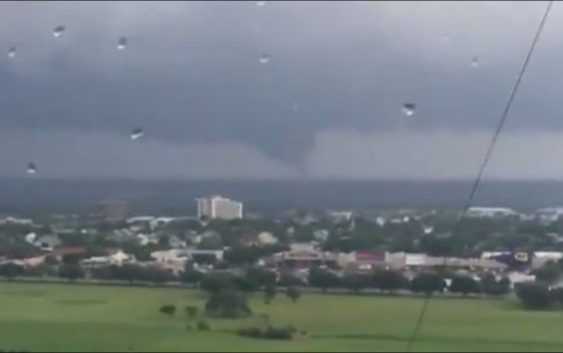- Couple accused of creating videos of young girls using hidden cameras at The Woodlands Mall, Hurricane Harbor
- Couple accused of creating videos with hidden cameras at The Woodlands Mall, Hurricane Harbor
- The Texanist: Texas Gets More Tornadoes Than Any Other State, but Don’t Freak Out
- U.S. Supreme Court says Texans can sue state for flood damage
- This is how many hurricanes NC State researchers predict this year
What to do before, during and after a tornado

With several tornado warnings Friday, it’s a good time to brush up on what you should do before during and after a tornado. (Tips and information from ready.gov/tornadoes)
Before a Tornado
- Identify safe rooms built to FEMA criteria or ICC500 storm shelters or other potential protective locations in sturdy buildings near your home, work, and other locations you frequent so you have a plan for where you will go quickly for safety when there is a warning or an approaching tornado.
- For schools, malls, and other buildings with long-span roofs or open space plans, or many occupants, ask the building manager to identify the best available refuge.
- Build an emergency kit and make a family communications plan.
- Follow KHOU on air, online and on mobile for the latest watches and warnings. Make sure your cell phone is fully charged when severe weather is in the forecast in case you lose power.
- Be alert to changing weather conditions. Look for approaching storms.
- Look for the following danger signs:
- Dark, often greenish sky
- Large hail
- A large, dark, low-lying cloud (particularly if rotating)
- Loud roar, similar to a freight train.
- If you see approaching storms or any of the danger signs, be prepared to take shelter immediately.
RELATED: Possible tornadoes leave damage near La Grange in Fayette County
During a Tornado
If you are under a tornado warning, seek shelter immediately! Most injuries associated with high winds are from flying debris.
If you’re at home:
Go to a small interior windowless room on the lowest level, below ground in a basement, or storm cellar, is best. A closet or interior hallway are also options.
Put as many walls as possible between you and the outside.
Get under a sturdy table and cover your head and neck with your arms and cover your body as best you can e.g., with a heavy coat or blankets, pillows.
Remember to protect your head. If you have football, motorcycle or bike helmets, put them on.
If you are in school, nursing home, hospital, factory, shopping center or high-rise:
- Go to a pre-designated area such as a safe room built to FEMA criteria, or a small interior windowless room on the lowest level, below ground in a basement, or storm cellar, is best. (closet, interior hallway) away from corners, windows, doors and outside walls. Put as many walls as possible between you and the outside. Get under a sturdy table and cover your head and neck with your arms and cover your body as best you can e.g., with a heavy coat or blankets, pillows.
- In a high-rise building, go to a small interior room or hallway on the lowest floor possible.
- Do not open windows.
- A sturdy structure (e.g. residence, small building) , school, nursing home, hospital, factory, shopping center, high-rise building)
A manufactured home or office then:
- Get out immediately and go to a pre-identified location such as the lowest floor of a sturdy, nearby building or a storm shelter. Mobile homes, even if tied down, do not offer protection from tornadoes.
The outside with no shelter then:
- If you are not in a sturdy building, there is no single research-based recommendation for what last-resort action to take because many factors can affect your decision. Possible actions include:
- Immediately get into a vehicle, buckle your seat belt and try to drive to the closest sturdy shelter. If your vehicle is hit by flying debris while you are driving, pull over and park.
- Take cover in a stationary vehicle. Put the seat belt on and cover your head with your arms and a blanket, coat or other cushion if possible.
- In all situations:
- Do not get under an overpass or bridge. You are safer in a low, flat location.
- Never try to outrun a tornado in urban or congested areas in a car or truck. Instead, leave the vehicle immediately for protection in a sturdy building. .
- Outdoor areas are not protected from flying debris. Flying debris from tornadoes causes most fatalities and injuries.
After a Tornado
- If you are trapped, do not move about or kick up dust. Tap on a pipe or wall or use a whistle, if you have one, so that rescuers can locate you.
- Listen to local officials for updates and instructions.
- Check-in with family and friends by texting or using social media.
- Watch out for debris and downed power lines.
- Stay out of damaged buildings and homes until local authorities indicate it is safe.
- Use extreme caution during post-disaster clean-up of buildings and around debris. Do not attempt to remove heavy debris by yourself. Wear protective clothing, including a long-sleeved shirt, long pants, work gloves, and sturdy, thick-soled shoes during clean-up.
- Photograph the damage to your property in order to assist in filing an insurance claim.
- Do what you can to prevent further damage to your property, (e.g., putting a tarp on a damaged roof), as insurance may not cover additional damage that occurs after the storm.
- If your home is without power, use flashlights or battery-powered lanterns rather than candles to prevent accidental fires.
ALSO POPULAR ON KHOU.COM: